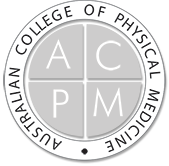
Australian College of Physical Medicine
Business / Practice Details
Business / Provider Type
Education Provider
Services Offered
Education
Profile
Business / Provider Profile
About Our College
Physical Medicine in Australia was formally established as the Australian College of Physical Medicine in 1989 as a "not for profit" postgraduate medical education organisation. It developed in response to a need recognised by a group of experienced general practitioners. These doctors found that there was a large proportion of primary care patients suffering from soft tissue musculoskeletal dysfunction and associated pain. They found that general practice lacked the expertise to assess and treat these diverse conditions. They found that soft tissue musculoskeletal dysfunction was only a very small part of the area of knowledge covered by orthopaedic surgical colleagues and rheumatologists, the latter dealing mainly with connective tissue disease of an autoimmune type. Rehabilitation Physicians, although in the past were involved in Physical Medicine, had narrowed their field of expertise and in recognition no longer included the term Physical Medicine in the description of their faculty.
General practitioners seeking assessment and treatment skills attended the RACGP Introductory Course in 1985 under Professor John Murtagh of Monash University and Dr Clive Kenna of Monash Medical Centre. This course was available for GPs of at least three years post hospital experience. Because of the interest shown by 2000 GPs who attended the course, a longer course with written and clinical examinations was later held at Monash Medical Centre, and a certificate awarded. After 1989, the certificate course became a conjoint course of the RACGP and ACPM. A formal programme of further training and examination was developed. After two further years of study and attending specific courses, admission to Fellowship via a written examination and clinical viva was approved.
Physical Medicine in Australia was formally established as the Australian College of Physical Medicine in 1989 as a "not for profit" postgraduate medical education organisation. It developed in response to a need recognised by a group of experienced general practitioners. These doctors found that there was a large proportion of primary care patients suffering from soft tissue musculoskeletal dysfunction and associated pain. They found that general practice lacked the expertise to assess and treat these diverse conditions. They found that soft tissue musculoskeletal dysfunction was only a very small part of the area of knowledge covered by orthopaedic surgical colleagues and rheumatologists, the latter dealing mainly with connective tissue disease of an autoimmune type. Rehabilitation Physicians, although in the past were involved in Physical Medicine, had narrowed their field of expertise and in recognition no longer included the term Physical Medicine in the description of their faculty.
General practitioners seeking assessment and treatment skills attended the RACGP Introductory Course in 1985 under Professor John Murtagh of Monash University and Dr Clive Kenna of Monash Medical Centre. This course was available for GPs of at least three years post hospital experience. Because of the interest shown by 2000 GPs who attended the course, a longer course with written and clinical examinations was later held at Monash Medical Centre, and a certificate awarded. After 1989, the certificate course became a conjoint course of the RACGP and ACPM. A formal programme of further training and examination was developed. After two further years of study and attending specific courses, admission to Fellowship via a written examination and clinical viva was approved.
Why us
The aim of our Physical Medicine clinic is to correctly diagnose somatic (bodily) dysfunctions, including restricted joint motion, muscles which are in spasm or which are hypotonic, altered muscle firing patterns and tight connective tissues such as ligaments or fascia. Such dysfunctions typically cause joint restrictions, pain, and nerve or vascular entrapment.
Diagnosis depends on taking a thorough history, noting the severity and location of the symptoms. Examination takes into account posture, gait and muscle behaviour patterns. The aim is then to reproduce the symptoms by palpation and joint motion testing. Care is taken to exclude possible underlying disease.
Some of the problems that we may be able to assist you in the management of are:
* migraine-like headaches, cervicogenic headaches
* neck stiffness or pain, acute and chronic whiplash
* shoulder stiffness or pain, shoulder dysfunction
* musculoskeletal chest pain, mid-scapular pain
* acute and chronic lower back pain
* musculoskeletal pelvic pain and dysfunction
* peripheral limb pain or paraesthesiae
* peripheral joint dysfunction
* elbow tendonitis
* foot pain, heel pain, ankle dysfunction
* disturbance of gait or posture
* TMJ dysfunction
Diagnosis depends on taking a thorough history, noting the severity and location of the symptoms. Examination takes into account posture, gait and muscle behaviour patterns. The aim is then to reproduce the symptoms by palpation and joint motion testing. Care is taken to exclude possible underlying disease.
Some of the problems that we may be able to assist you in the management of are:
* migraine-like headaches, cervicogenic headaches
* neck stiffness or pain, acute and chronic whiplash
* shoulder stiffness or pain, shoulder dysfunction
* musculoskeletal chest pain, mid-scapular pain
* acute and chronic lower back pain
* musculoskeletal pelvic pain and dysfunction
* peripheral limb pain or paraesthesiae
* peripheral joint dysfunction
* elbow tendonitis
* foot pain, heel pain, ankle dysfunction
* disturbance of gait or posture
* TMJ dysfunction
Business Address
Macquarie University NSW 2019, Australia
0 Follower(s)
